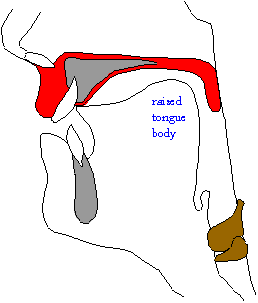

Not all L sounds in English are the same. There is a distinct difference between the L sound of leaf and the L sound of pool or full. The second kind is called a "dark L" and is usually transcribed with the symbol, [ɫ].
Some words with clear L:
| leaf | [lif] |
| black | [blæk] |
| lose | [luz] |
Some words with dark L:
| pool | [puɫ] |
| milk | [mɪɫk] |
| full | [fʊɫ] or [fɫ̩] |
Some words with both kinds of L:
| lull | [lʌɫ] |
| flail | [fleɫ] |
| little | [ˈlɪɾɫ̩] |
(As you can see, English Ls that are close to the beginning of the syllable are clear, while those close to the end of the syllable are dark.)
Clear [l] and dark [ɫ] both have an alveolar approximant constriction made by the tongue tip at the alveolar ridge, as shown below. (Remember that the cross-section of an [l] looks just like the cross-section of a [d] -- the lowering of the tongue tip/blade for the approximant happens at the side.) What makes the dark [ɫ] different from the clear [l] is an extra raising of the tongue body to the same position it has for a high back vowel.
clear [l] |
dark [ɫ] |
 |
 |
So, essentially dark [ɫ] is just a clear [l] pronounced simultaneously with a velar approximant [ɰ] -- just like [w] is really lip-rounding with a simultaneous [ɰ].